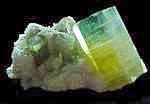

`
 |
 |
| Mining Operations at Mount Mica & Orchard Pit Mines, Oxford County, Maine. | |
Coromoto Minerals Mining
Operations at Mount Mica,
October, November, December 2007
|
Our mining around pocket 6 and 7 revealed many small vugs containing tourmaline and The next advance of the drift produced no pockets but the feldspar was showing the striped fabric that indicated pockets were around somewhere. It was also becoming increasingly clear that we were now mining the down side of a plunge. This complicated blasting as the pocket horizon was trending diagonally across our working face. There was no obvious 'safe zone' for blasting. We almost always drill into a pocket before it is exposed by blasting. When we don't, our practice is to blast either above or below the presumed location of the pocket zone hoping to 'peel' into something. In this way we spare small spaces that are not revealed during drilling. We have learned that different regions have their own particular 'no brainer 'pocket indicators. In this area the striped spar ( colored by possible lepidolite up take ) is a strong indicator. Our guess proved to be accurate as we soon drilled into a space. In the image above, the space sits immediately behind the dark stained area that is probably lepidolite. A closeup shows how the microcline coarsens near the pocket. Once we had chiseled into the pocket we saw that microcline formed its roof and had broken into many angular pieces. These microcline 'tiles' filled the upper portion of the pocket. Once we had cleared some of this material, more interesting crystals began to appear. The first was a large smoky quartz. It to be appeared oriented point down in the debris. At first only the stem was visible. We had no idea what it would amount to when excavated. We extracted it to find to our surprise it was a huge scepter quartz (60cm). On the stem of the scepter there was a mat of small blue tourmaline that graded to colorless near the pinacoid which in itself was red. We have learned from experience that, if a pocket has tourmaline, the color pattern of the first piece found will be a very good indicator of almost every other piece regardless of size. This was indeed an interesting combination and most probably a harbinger of what we might possibly find.
As we probed further into the pocket we began to find many small (2cm) tourmalines identical to those Digging a little more we found another section and then another. Three pieces comprised this beauty. On close inspection of the pocket roof we could see where, at one time, both the large quartz scepter and the tourmaline had been attached. The tourmaline had apparently begun growth as schorl and developed its color within the pocket. Interestingly, the break
In the image above showing the crystal sitting in front of the pocket beside a As we continued to expand the advance to the west (left) we opened another small face that produced one decent tourmaline section of gem quality. This section produced a very attractive blue-green stone of about 3 carats. Our hopes were high that we would find more of this particular shade of material. It did not happen. As we worked this area we could see that the feldspars were indicating promise. By then we were into November. Our plan, as discussed on other pages, was to leave a substantial pillar to support the roof. We set aside about a 6m square of pegmatite for this purpose. At this point we decided to work the pegmatite just to the west of the pillar and in a southerly direction. Though the mineralization looked promising, the steep dip made working the pegmatite difficult. After struggling with
trickled water, so we convinced ourselves more was ahead of. It just required a little tonnage...as always does. The small green matchsticks pictured above resembled some of the watercolors Hamlin made of crystals found in the 'New Pit' and illustrated in his book 'The History of Mount Mica'. Though I possess an original, I frequently consult my reprint of this work produced by Rubellite Press. These resembled plate XLII depicting crystals found in November of 1893.We were indeed working within the pegmatite just below the New Pit. Perusing Hamlin's illustrations I could see none reminiscent of Fuji. This was an interesting area to mine but I was constantly troubled by the notion that .though the pickings were, good, the future in this direction was limited. Mining further north we would break to the outside. Although substantial pegmatite lay between us and the main pit going westward, this too was an exhaustible heading. As difficult going as it was, I much preferred mining eastward where no limit has been established. Some observers believe that the pegmatite in that direction will change chemical composition, or at least segregation, such that, though it will still be Mount Mica, its beautiful crystal creations will be exhausted. I don't think so. We hope to prove it on our watch at Mount Mica. |